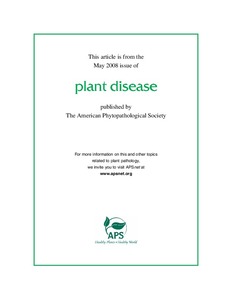| dc.contributor.author | Afolabi, C.G. |
| dc.contributor.author | Ojiambo, P.S. |
| dc.contributor.author | Ekpo, E.J. |
| dc.contributor.author | Menkir, A. |
| dc.contributor.author | Bandyopadhyay, Ranajit |
| dc.date.accessioned | 2019-12-04T11:15:01Z |
| dc.date.available | 2019-12-04T11:15:01Z |
| dc.date.issued | 2008 |
| dc.identifier.citation | Afolabi, C.G., Ojiambo, P.S., Ekpo, E.J., Menkir, A. & Bandyopadhyay, R. (2008). Novel sources of resistance to Fusarium stalk rot of maize in tropical Africa. Plant Disease, 92(5), 772-780. |
| dc.identifier.issn | 0191-2917 |
| dc.identifier.uri | https://hdl.handle.net/20.500.12478/2898 |
| dc.description.abstract | Fusarium stalk rot is one of the most widespread and destructive diseases of maize, and deployment of resistant genotypes is one of the most effective strategies for controlling the disease. Fifty inbred lines and four checks from the breeding program of the International Institute of Tropical Agriculture were evaluated in field trials at Ikenne and Ibadan, Nigeria in 2003 and 2004 to identify new sources of resistance to stalk rot caused by Fusarium verticillioides. Evaluations were conducted under artificial inoculation and natural infection at Ibadan and Ikenne, respectively. Disease severity was recorded using a severity scale (SS) and direct estimation of stalk discoloration (SD). The two methods of disease assessment were compared and combined to classify genotypes into resistance groups using results from rank-sum analysis. In 2003, disease severity ranged from SS = 1 to 5 and SD = 1.3 to 33.8% at both locations. Both SS and SD were significantly (P < 0.01) higher in 2003 than in 2004 at the two locations. In both years, inbred lines significantly differed in SS (P < 0.02) and SD (P < 0.04) at Ibadan. Similarly, inbred lines significantly differed in SS (P < 0.04) and SD (P < 0.04) when genotypes were evaluated at Ikenne. Disease assessments based on SS and SD were significantly correlated (0.68 < r < 0.95, P < 0.01) in both years. Based on the results from rank-sum analysis, inbred lines were separated into highly resistant, resistant, moderately resistant, moderately susceptible, susceptible, and highly susceptible groups. At Ibadan, 6 (11.1%) and 8 (14.8%) were identified as highly resistant and resistant, respectively, whereas 11 (20.4%) were identified as resistant at Ikenne. Inbred lines 02C14609, 02C14643, 02C14654, and 02C14678 were consistently classified as either highly resistant or resistant to stalk rot across locations and years while the check genotypes were classified either as susceptible or moderately susceptible to stalk rot. These four inbred lines identified to have high levels of disease resistance may be used for breeding maize with resistance to Fusarium stalk rot. |
| dc.language.iso | en |
| dc.subject | Fusarium Stalk Rot |
| dc.subject | Genotypes |
| dc.subject | Diseases |
| dc.subject | Breeding |
| dc.subject | Maize |
| dc.title | Novel sources of resistance to Fusarium stalk rot of maize in tropical Africa |
| dc.type | Journal Article |
| dc.description.version | Peer Review |
| cg.contributor.affiliation | International Institute of Tropical Agriculture |
| cg.contributor.affiliation | North Carolina State University |
| cg.contributor.affiliation | University of Ibadan |
| cg.coverage.region | Africa |
| cg.coverage.region | West Africa |
| cg.coverage.country | Nigeria |
| cg.isijournal | ISI Journal |
| cg.authorship.types | CGIAR and developing country institute |
| cg.iitasubject | Plant Diseases |
| cg.iitasubject | Disease Control |
| cg.iitasubject | Plant Breeding |
| cg.iitasubject | Maize |
| cg.iitasubject | Genetic Improvement |
| cg.accessibilitystatus | Limited Access |
| local.dspaceid | 93999 |
| cg.identifier.doi | http://dx.doi.org/10.1094/PDIS-92-5-0772 |

